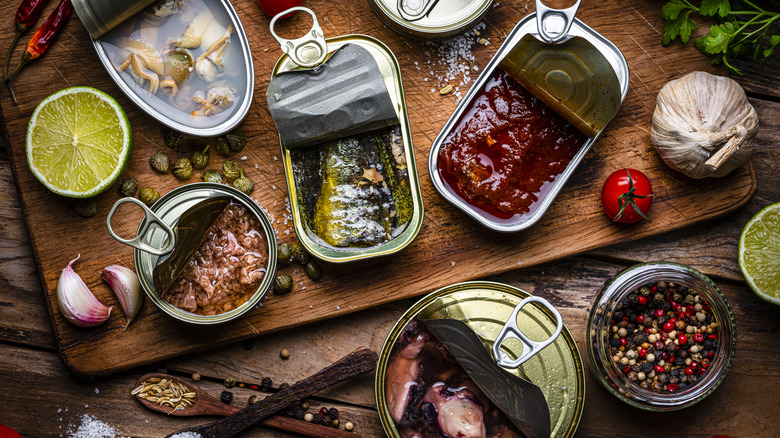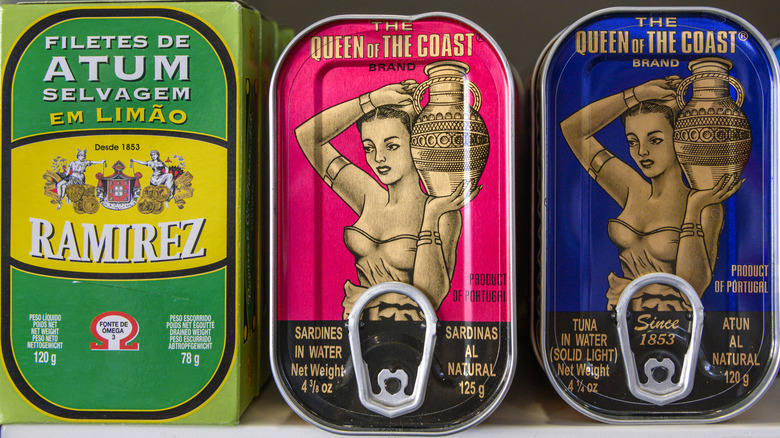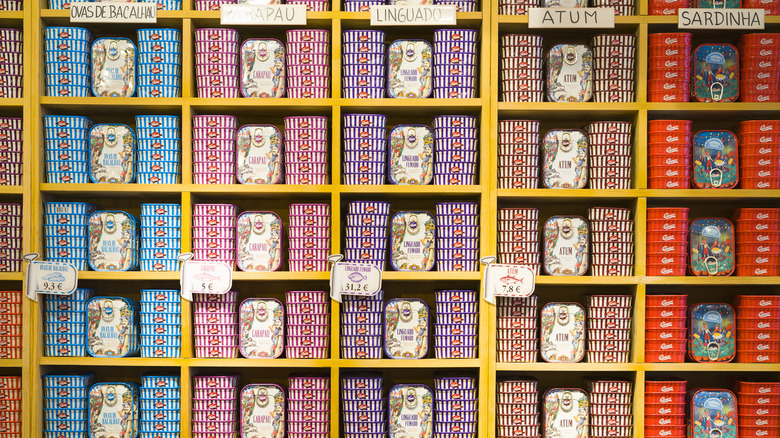When It Comes To Canned Fish, Does More Expensive Mean Better?
One of the major draws to canned fish is its affordability. A can of tuna will often cost you a dollar or two at the grocery store — or even less if you buy in bulk. But what happens when you invest in your tinned seafood? You might be thinking, "Canned fish is still just fish in a can," but that is not necessarily true. Quite a few factors contribute to the final cost of a canned fish product, such as the labor that goes into catching and processing, the species of fish, the texture of the cut, and the packing liquid. With all of that taken into consideration, some tins of various fish can fetch up to $8, $22, or nearly $40.
More expensive often means wild-caught fish, hand-packed containers, and sustainable practices. Of course, there is also variety that comes with expense. When you're willing to pay a bit more, the door of possibilities opens. Now, does all of that necessarily mean better? That's up to you, but experts would certainly agree with the old saying, "You get what you pay for." Consider whether you are shopping for a cheap meal where you are free to experiment with flavors of your own, or a ready-to-eat seafood tasting to determine if the more expensive option is right for you.
Various factors make some canned fish more expensive
All canned fish must be shelf-stable, meaning they are safe to sit at room temperature. To do this, the cans are vacuum-sealed and heat-processed to kill microorganisms that could cause the food to spoil. However, not all fish are canned the same.
Take tuna, for example, one of the best foods to eat straight from the can. Different species, like skipjack, albacore, and yellowfin tuna, have different market prices depending on supply and demand. Skipjack, for instance, actually makes up around 70% of the tuna market, and tends to be the most abundant and the most affordable. For texture, there is "solid," which has larger pieces still intact and requires a careful hand during preparation, and "chunk," which tends to be drier and flakier but promises no particular cut.
Some high-end cans of tuna are preserved in brine or olive oil instead of water, driving up the price but leading to an arguably tastier product. Certain companies invest in sustainable practices that require fish to be wild-caught, which raises the labor cost. All of these factors add up to the final price, along with the batch size, packaging, and labor associated with the product. This is why Spain and Portugal have the best canned tuna around — it's all due to the premium-cut tuna sitting in a hand-packaged tin of high-quality EVOO.
Canned fish can help you craft a specific culinary experience
At the end of the day, whether the canned fish lives up to its price tag depends on what you're looking to get out of your seafood. Experts can spot the differences between cheap, waterlogged chunk tuna in a can and solid tuna preserved in olive oil and appreciate the subtleties in their luxury brands, but you might not even like the texture olive oil gives the fish. Why pay more to enjoy your food less?
Spending a little more for pickled oysters or seasoned sardines to enjoy with your wine and charcuterie might be a good idea if you intend to create a tinned fish tasting and explore new flavors of seafood. If you're planning on mixing up a tuna salad for a big family cookout, then you'd be wise to go with the economical option. There are plenty of scenarios where you might want to use a more expensive canned tuna in olive oil instead of in water, and vice versa.
To those looking to hop on the luxury canned fish trend, start small. You don't need to dump hundreds of dollars into canned fish-of-the-month subscriptions as you learn the ropes, but understand that investing an extra couple of bucks per can might be the difference between a snack and an experience — one that may or may not be for you. Either way, it's still fun to try something new!



